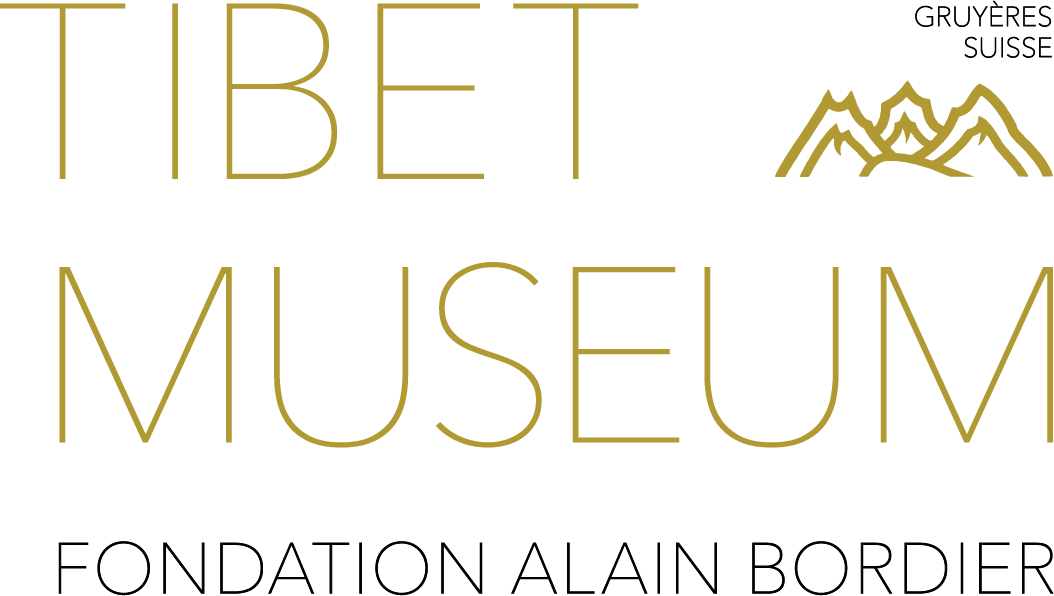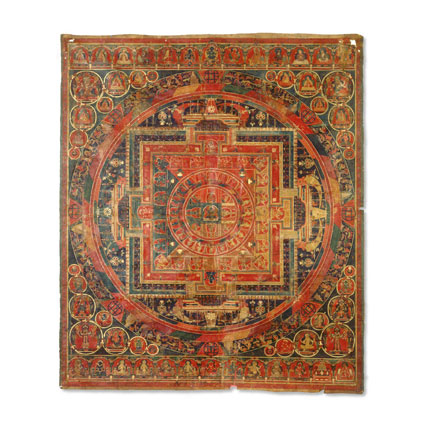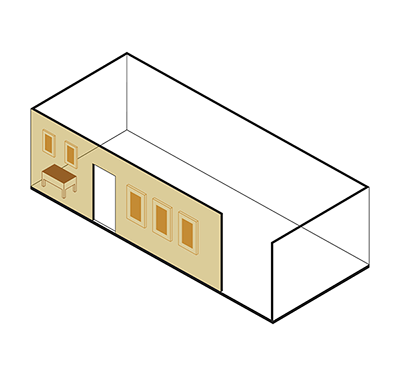Add to favorites
ABP 002
Code: ABP 002
Country: Tibet (south)
Style:
Date: 1300 - 1400
Dimensions in cm WxHxD: 89.5 x 106
Materials: Glue distemper on cotton
Yogambara mandala
This large and refined mandala represents the heavenly abode of Yogambara (Tib. rnal ‘byor nam mkha’), a male deity connected to the tantric cycle of Catuspitha (Tib. gdan bzhi). At the centre of the mandala’s palace sits the blue Yogambara with three faces and six hands. Embracing him is his white consort Jñanadakini. Around them the 77 deities of their retinue are displayed in the mandala. The upper range gathers 13 characters from the transmission lineage starting at the centre with Vajradhara.
The back of the canvas is inscribed with many mantras and syllables in Sanskrit as well as dedication verses in cursive Tibetan writing. References are made to the rNgog transmission lineage as well as Zhwa lu. The mantras written in Rañjana script behind each master of the upper range allow us to identify some of the characters among which Nagarjuna, Aryadeva, Tilopa, Naropa, Mar pa, rNgog Chos sku rDo rje, Dar ma mDo sde and so forth. These names clearly designate the little-known and discrete rNgog pa bKa’ brgyud tradition, stemming directly from Mar pa Lo tsa ba, whose tradition of Catuspitha and Yogambara was passed down until the 16th century before spreading among other lineages.
From a lineage perspective, this painting is connected to the dPal ldan lha mo (ABP 009), both of them being related to the rNgog lineage of the bKa’ brgyud school.
Inscriptions:
Two groups of Tibetan inscriptions are visible on the reverse of the painting.
རྒྱུད་(?) འ་ལ་ཨཱརྱ་དེ་བ་ ཐུ་ལ་རྡོར་ཕྲེང་། ཁ་དྲས་ངེ་པ་ལ་རྔོག་པའི་གདན་བཞི།
rgyud (?) | ’a la ārya de ba | thu la rdor phreng | kha dras nge pa la rnog pa’i gdan bzhi/
[L1] ༄། མང་དུ་ཐོས་པ་ཀུན་དགའ་ཞེས་བྱ་བས། ཞ་ལུ་བ་དང་། གདན་བཞི་ལྷ་མངས་ཀྱི་རྒྱུད་ཡིག་ནི། བདག་ཆེན་འཇཾ་དབྱངས་པའི་ཐུགས་དཾ་ཐང་ཀ་
[L2] ཆེན་མོའི་རྒྱབ་ལ་བྲིས་ཡོད། དེ་ཁ་དང་ལྷ་བཀོད་༡་པའི་སྤྱན་སྔ་གྲགས་བྱང་པའི་ཐུཌ་དཾ་ཐང་ཀ་ཆུང་ངུ་ཞིག་ཀྱང་ཡོད་དོ། རྔོག་པས་ཀེང་རུས་ཀྱི་སེཾདའ[སེམས་དཔའ་]
[L3] བཅུག་[བཅུ་དྲུག] ཏུ་བྱས་ཏེ། དེ་དང་རི་མོ་གྲངས་གཅིག་ཙམ་འདུག་པས་ཕྲེང་བའི་རྒྱབ་ལ་བྲིས་ན་བསཾ་པའི་དེ་མ་ཐག་བློ་འགྱུར་ནས། པཎ་ཆེན་ཟུར་བཀའི་རྒྱབ་ལ་བྲིས་སོ།
mang du thos pa kun dga’ zhes bya bas/ zhwa lu ba dang / gdan bzhi lha mangs kyi rgyud yig ni/ bdag chen ’jaṃ dbyangs pa’i thugs daṃ thang ka
chen mo’i rgyab la bris yod/ de kha dang lha bkod 1 [gcig] pa’i spyan snga grags byang pa’i phreng ba’i thuḍ daṃ [thugs dam] thang ka chung ngu zhig kyang yod do/ rngog pas keng rus kyi seṃda’ [sems dpa’]
bcug (bcu drug] tu byas te/ de dang rim o grangs gcig tsam ’dug pas phreng ba’i rgyab la bris na bsaṃ pa’i de ma thag blo ’gyur nas/ paṇ chen zur bka’i rgyab la bris so/
This large and refined mandala represents the heavenly abode of Yogambara (Tib. rnal ‘byor nam mkha’), a male deity connected to the tantric cycle of Catuspitha (Tib. gdan bzhi). At the centre of the mandala’s palace sits the blue Yogambara with three faces and six hands. Embracing him is his white consort Jñanadakini. Around them the 77 deities of their retinue are displayed in the mandala. The upper range gathers 13 characters from the transmission lineage starting at the centre with Vajradhara.
The back of the canvas is inscribed with many mantras and syllables in Sanskrit as well as dedication verses in cursive Tibetan writing. References are made to the rNgog transmission lineage as well as Zhwa lu. The mantras written in Rañjana script behind each master of the upper range allow us to identify some of the characters among which Nagarjuna, Aryadeva, Tilopa, Naropa, Mar pa, rNgog Chos sku rDo rje, Dar ma mDo sde and so forth. These names clearly designate the little-known and discrete rNgog pa bKa’ brgyud tradition, stemming directly from Mar pa Lo tsa ba, whose tradition of Catuspitha and Yogambara was passed down until the 16th century before spreading among other lineages.
From a lineage perspective, this painting is connected to the dPal ldan lha mo (ABP 009), both of them being related to the rNgog lineage of the bKa’ brgyud school.
Inscriptions:
Two groups of Tibetan inscriptions are visible on the reverse of the painting.
རྒྱུད་(?) འ་ལ་ཨཱརྱ་དེ་བ་ ཐུ་ལ་རྡོར་ཕྲེང་། ཁ་དྲས་ངེ་པ་ལ་རྔོག་པའི་གདན་བཞི།
rgyud (?) | ’a la ārya de ba | thu la rdor phreng | kha dras nge pa la rnog pa’i gdan bzhi/
[L1] ༄། མང་དུ་ཐོས་པ་ཀུན་དགའ་ཞེས་བྱ་བས། ཞ་ལུ་བ་དང་། གདན་བཞི་ལྷ་མངས་ཀྱི་རྒྱུད་ཡིག་ནི། བདག་ཆེན་འཇཾ་དབྱངས་པའི་ཐུགས་དཾ་ཐང་ཀ་
[L2] ཆེན་མོའི་རྒྱབ་ལ་བྲིས་ཡོད། དེ་ཁ་དང་ལྷ་བཀོད་༡་པའི་སྤྱན་སྔ་གྲགས་བྱང་པའི་ཐུཌ་དཾ་ཐང་ཀ་ཆུང་ངུ་ཞིག་ཀྱང་ཡོད་དོ། རྔོག་པས་ཀེང་རུས་ཀྱི་སེཾདའ[སེམས་དཔའ་]
[L3] བཅུག་[བཅུ་དྲུག] ཏུ་བྱས་ཏེ། དེ་དང་རི་མོ་གྲངས་གཅིག་ཙམ་འདུག་པས་ཕྲེང་བའི་རྒྱབ་ལ་བྲིས་ན་བསཾ་པའི་དེ་མ་ཐག་བློ་འགྱུར་ནས། པཎ་ཆེན་ཟུར་བཀའི་རྒྱབ་ལ་བྲིས་སོ།
mang du thos pa kun dga’ zhes bya bas/ zhwa lu ba dang / gdan bzhi lha mangs kyi rgyud yig ni/ bdag chen ’jaṃ dbyangs pa’i thugs daṃ thang ka
chen mo’i rgyab la bris yod/ de kha dang lha bkod 1 [gcig] pa’i spyan snga grags byang pa’i phreng ba’i thuḍ daṃ [thugs dam] thang ka chung ngu zhig kyang yod do/ rngog pas keng rus kyi seṃda’ [sems dpa’]
bcug (bcu drug] tu byas te/ de dang rim o grangs gcig tsam ’dug pas phreng ba’i rgyab la bris na bsaṃ pa’i de ma thag blo ’gyur nas/ paṇ chen zur bka’i rgyab la bris so/
The piece is featured in this book This book is available at the museum's library Bock, Etienne; Falcombello, Jean-Marc; Jenny Magali, 2022. Trésors du Tibet. Sur les pas de Milarépa. Paris: Flammarion. P. 164-167


